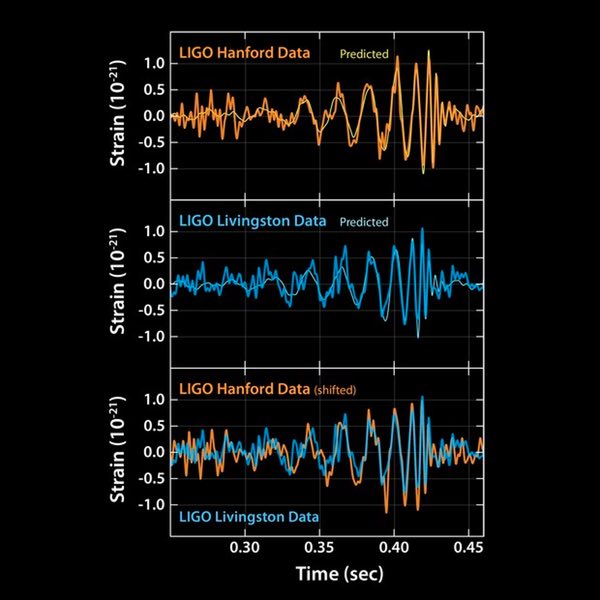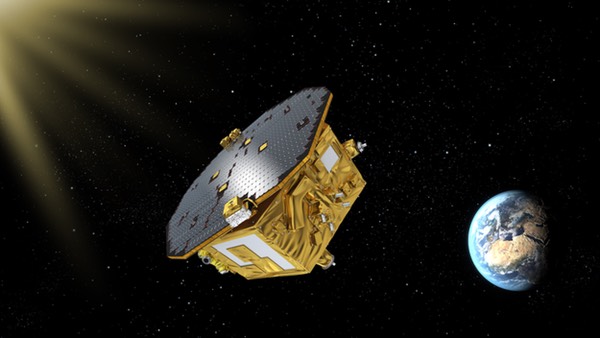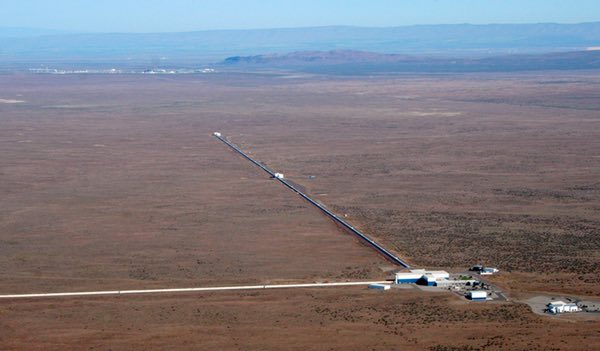A thump in the nightby Jeff Foust
|
| “Ladies and gentlemen, we have detected gravitational waves,” said Reitze. “We did it!” |
Whatever you called it, though, it was music to physicists’ ears. “Isn’t it amazing? I can’t stop playing it,” said Gabriela González, a professor of physics at Louisiana State University, during a talk at the annual meeting of the American Association for the Advancement of Science (AAAS) last Friday in Washington, DC. She said that after playing the sound clip of the chirp several times—and then played it again.
Her talk came a day after she and other scientists involved with the Laser Interferometer Gravitational-wave Observatory (LIGO) held a press conference to announce the first direct detection of gravitational waves. The media universally heralded the announcement as a vindication of Albert Einstein’s theory of general relativity, which predicted such waves a century ago.
After decades of efforts to detect gravitational waves, and weeks of rumors that LIGO had detected something, project scientists waited no time at the briefing to break the news. “Ladies and gentlemen, we have detected gravitational waves,” said David Reitze, executive director of the LIGO Laboratory, shortly after the press conference got underway. “We did it!”
The gravitational waves, travelling more than a billion light-years, reached the LIGO facility near Livingston, Louisiana, in the pre-dawn hours of September 14. Seven milliseconds later, the twin LIGO facility near Hanford, Washington, some 3,000 kilometers away, also detected the waves.
The detection at both sites was the first clear sign that the signal was real, and not just random noise. “If you see the same thing in both detectors, you know it’s not an artifact or a local disturbance,” González said.
But, she noted, it could be a coincidence. “We have seen many, many, many coincidences between Hanford and Livingston, but they have always, up to now, been consistent with what we expect from random noise,” she said.
| “With this discovery, we humans are embarking on a marvelous new quest: the quest to explore the warped side of the universe,” said Thorne. |
That required further analysis to see how frequent such coincidences could be. For a signal as strong as the one, the false detection rate caused by such random coincidences should be very low. “We don’t expect a coincidence this strong more often than one in 200,000 years,” she said, adding this was an upper bound: such coincidences may be even less frequent. That gave the LIGO team the confidence to conclude that the signal they detected was, in fact, a gravitational wave.
“We have detected gravitational waves. It is amazing,” González said, a line that generated an impromptu round of applause in the middle of her AAAS talk.
 The gravitational wave detected by the two LIGO facilities. (credit: LIGO Laboratory) |
Such waves eluded detection in the past because their effects are so minute. At the LIGO facilities, which feature L-shaped laser beams four kilometers long with precisely positioned mirrors at each end, last September’s gravitational wave stretched out the beam by about one ten-thousandth of the diameter of a proton. LIGO had been searching for gravitational waves for years, and found this one only after an upgrade, dubbed Advanced LIGO, that improved its sensitivity by about a factor of three.
So what created this infinitesimal distortion in spacetime? The waveform seen, including the frequencies detected, is consistent with models of the collision of two black holes, astronomers said. The two black holes weighed 29 and 36 times the mass of the Sun, and created a black hole of about 62 solar masses. That difference of three solar masses was the mass converted into energy, primarily into gravitational waves.
That same modeling indicated that the collision took place about 1.3 billion light-years away, and somewhere in the southern hemisphere (the waves reached Livingston before Hanford), but with only two detectors, it’s not possible to triangulate a more specific location.
Immediately after the detection, the LIGO team alerted astronomers, including a team at the four-meter Blanco telescope at the Cerro Tololo Inter-American Observatory in Chile. They used a wide-field camera to scan hundreds of square degrees of the sky to see of they could detect a visible signal that could be linked to the gravitational wave signal.
That search came up empty, but astronomers involved said it provided a good experience for future searches. “This first attempt to detect visible light associated with gravitational waves was very challenging,” said Edo Berger of the Harvard-Smithsonian Center for Astrophysics in a statement about the search, “but it paves the way to a whole new field of astrophysics.”
That was a sentiment shared by other scientists involved in the LIGO discovery, who see it not just as additional verification of Einstein’s theory of general relativity—which many previous tests had validated—but as another tool for astronomers to understand the universe.
| “We have much more data to analyze and there are some excellent candidates, so I’m feeling very optimistic,” Hough said of potential additional gravitational wave discoveries. |
“With this discovery, we humans are embarking on a marvelous new quest: the quest to explore the warped side of the universe—objects and phenomena that are made from warped spacetime,” said Kip Thorne, a Caltech professor of theoretical physics who helped conceive of LIGO in the 1980s, in a statement. “Colliding black holes and gravitational waves are our first beautiful examples.”
One immediate outcome of the discovery, beyond its validation of general relativity, is that it demonstrated the existence of medium-sized black holes. There was evidence for smaller black holes, and the supermassive ones with masses millions of times the Sun found in the centers of galaxies, but none that weighed a few dozen times the Sun.
“The astronomical community were not expecting there to be any black holes of 30 solar masses,” said James Hough of the University Glasgow at the end of an AAAS meeting session Saturday on another cosmological mystery, dark matter. “As yet, there are no models for how they can be produced.”
The LIGO discovery is just the beginning of future gravitational wave science. The detection was made near the beginning of a four-month initial observing run with Advanced LIGO. Only one month of that data has been fully analyzed, González said.
There are already hints that there may be more gravitational wave signatures in the data from that brief run. “We have much more data to analyze and there are some excellent candidates, so I’m feeling very optimistic,” Hough said, adding that the team would not announce any additional gravitational wave detections “until we have done a complete analysis of them.”
LIGO is scheduled to come back online in the summer. It will soon be joined by other gravitational wave observatories under development in Italy and Japan, while India is expressing interest in developing its own. Those facilities should help in the detection and triangulation of gravitational wave sources, aiding follow-up observations by others.
And then there are the prospects of space-based observations of gravitational waves. The relatively short baselines of terrestrial facilities like LIGO make it difficult to detect gravitational waves with longer periods, which could be produced by the collisions of larger black holes and entire galaxies. They could be detected in space, though, where spacecraft could create baselines millions of kilometers long.
 An illustration of LISA Pathfinder, a spacecraft launched last December to demonstrate technologies for future space-based gravitational wave observatories. (credit: ESA) |
That was the concept behind a mission called the Laser Interferometer Space Antenna (LISA), jointly studied in the early 2000s by NASA and ESA. It would have flown three spacecraft up to five million kilometers apart from one another, using lasers—like in LIGO—to detect gravitational waves. In 2011, NASA, citing constrained budgets and the fact that LISA was rated lower in the latest astrophysics decadal survey to the WFIRST space telescope, decided to drop plans to pursue LISA.
ESA has continued LISA on a small scale with a technology demonstration mission called LISA Pathfinder, launched last December. The spacecraft, located at the Earth-Sun L-1 Lagrange point, features test masses that spacecraft controllers are in the process of releasing within the spacecraft. Once released, the spacecraft will maneuver to keep centered on them, demonstrating the precise positioning needed for a future space-based gravitational wave observatory.
| “I’m really hoping that with this news, and the excitement everyone has about this, that date can some sooner,” González said of ESA’s current plan for a 2034 gravitational wave mission. |
LISA Pathfinder itself won’t detect gravitational waves, but will show how it could be done. “With LISA Pathfinder, we will be testing the underlying technology to observe gravitational waves from space, and it is even more encouraging to know that these long-mysterious fluctuations have now been directly detected,” said Paul McNamara, LISA Pathfinder project scientist at ESA, in a statement.
ESA does have long-term ambitions for something like LISA—but with an emphasis on long-term. The agency has identified a gravitational wave observatory as a future large science mission, designated L3. Under ESA’s current timeline for its “Cosmic Vision” space science strategy, the L3 mission would not launch until 2034, after a Jupiter orbiter mission called JUICE and an x-ray observatory called Athena.
While that mission will be led by ESA, NASA may also be involved in some form. Last month, the agency announced the creation of an L3 Study Team, a group of scientists who will examine what role NASA could play in that mission and incorporate that planning into the next astrophysical decadal survey, to be completed in 2020.
Some scientists hope the gravitational wave discovery will accelerate ESA’s schedule. “I’m really hoping that with this news, and the excitement everyone has about this, that date can some sooner,” González said. “We hope it flies some time in the next decade. That would be great.”
That acceleration seems unlikely, given the magnitude of a mission like LISA (whose estimated cost, at the time of the 2010 decadal, was $2.4 billion) and the timescales needed to develop them: WFIRST, the top priority in the 2010 report, won’t fly until the mid-2020s. And a mission like LISA will have to complete with concepts like advanced space telescopes to study exoplanets and the distant, early universe in the next decadal.
There’s also the question of whether the excitement in evidence last week can be sustained. It might turn out to be like a gravitational waveform: a brief burst that disappears into the noise in a fraction of a second. While the discovery dominated the news for a day—likely because of the “Einstein was right” hook—it soon faded from public view.
González’s talk at the AAAS meeting, on a Friday morning, was in a large room that could accommodate nearly 2,000 people. Her talk, added to the schedule relatively late in the planning process, attracted an audience that filled less than half the room. The next afternoon, Jennifer Doudna of the University of California Berkeley gave a talk in the same room about a new genome editing approach known as CRISPR. Her talk filled the room, with people standing on the side and in the back.
It’s entirely possible that other factors—publicity, scheduling, etc.—can account for the difference in the crowds. But then, you also have to be really interested in a topic if you’re willing to sit in a crowded room at five o’clock on a Saturday afternoon. Perhaps CRISPR might seem more relevant to the general science community than another validation of general relativity.
Of course, general relativity itself once was little more than an intellectual curiosity, a way of explaining the orbit of Mercury without needing another planet even closer to the Sun that astronomers could not find. Today, knowledge of general relativity is essential to accurate timekeeping required by GPS and other satellite navigation systems. Will gravitational waves some day have some similar relevance, or will they remain academic tools that “only” help us better understand the universe?
